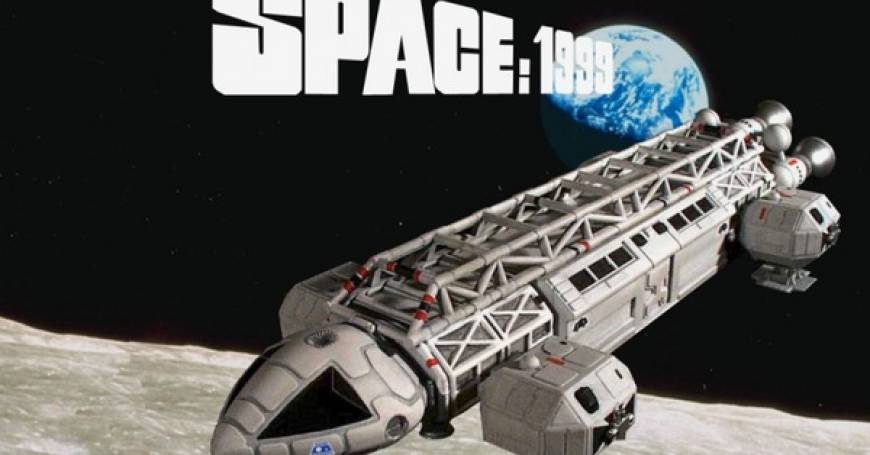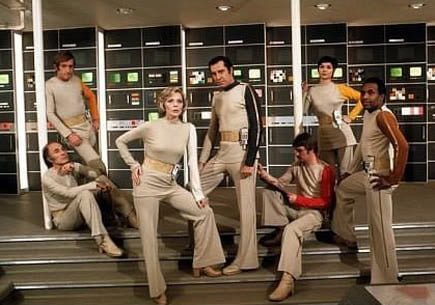
Brits have been making quality science fiction TV for decades now; this fact is not in dispute. Look no further than acclaimed cult hits like ‘Doctor Who‘ and ‘Red Dwarf’ for prime examples of awesome longevity from our friends across the pond (or on your side of the pond, for our European and Asian readership). But did you know that in the mid-1970s, the production super-duo of Gerry and Sylvia Anderson put their heads together for one last time in their career, and came up with the idea for one of the craziest and most intriguing sci-fi shows of all time: ‘Space:1999!’
First aired in 1975, the series was set in the not-too-distant future of 25 years hence, in 1999; as the premise goes, man had created its first military/exploratory settlement on the moon, aptly named Moonbase Alpha. Also on the Moon – over on the “dark side?” – the biggest and deadliest landfill ever created by humans – a nuclear storage waste facility. And darn the luck – but wouldn’t you know it – something goes wrong, and on September 13, 1999, the nuclear waste undergoes an unexpected enegry build-up and explodes, knocking the Moon out of Earth’s orbit.
Here’s the intriguing twist for the series: the Moon isn’t just knocked out of Earth orbit, it in effect becomes a speeding rocket ship, carrying the 300-plus inhabitants on Moonbase Alpha – “Alphans,” as the series comes to describe them – on a long and strange interstellar voyage. Since they are on a moving planetoid that’s on a one-way trip at a speed of predetermined velocity, the Alphans’ opportunity to explore or interact with alien species and situations they encountered was critically predetermined. Fortunately, the moon base was equipped with a decent supply of shuttles – iconically-designed spacecraft called Eagles – that allowed the crew to come and go from the travelling Moon pretty much as they pleased.
Obviously – and as with some of the greatest sci-fi of our time – the premise of the show must be taken with a grain of salt. As a prime example, and thankfully for the crew, the Moon finds itself on a course that never puts it in too serious of peril in colliding with anything too major out there in the great beyond. Even Isaac Asimov weighed in, famously quoting that an explosion of that size would likely rip the Moon apart, and even if the satellite did manage to leave Earth orbit intact, it would be thousands of years before it would even come in contact with the nearest star. Producers took some of this to heart, writing action and dialogue into later episodes that showed the Moon going through a black hole and a few “space warps” in order to indicate that it had moved further and further out into unknown space.
Frustratingly, certain themes created throughout the two-season run of the series never quite came to fruition; while the first season had several episodes that hinted at the possibility of the nuclear explosion being influenced by a “mysterious force,” this idea was never fully explored, and it was largely abandoned in the second season for a more episode-by-episode, action-movie-style approach. One of the biggest laments of fans is that, while the show followed the lives and trials of the Alphans on their journey, the ramifications and consequences of the Moon’s exit on Earth itself was never explored.
At the time of its production, ‘Space: 1999’ was the most expensive television series to ever come out of the United Kingdom – an impressive feat, especially when you remember that ‘Doctor Who’ had been on the air for over a decade by the time this show was released. The show’s title sequence, which showed viewers brief flashes from the episode they were about to watch, was ground-breaking for its time, and was directly referenced by Ron Moore as being a direct influence on his opening title sequences for his mid-2000s ‘Battlestar Galactica’ reboot.
‘Space: 1999’ was quintessentially a 1970s TV series, from the look and dialogue all the way down to the groovy orchestra-mixed-with-disco theme song. Obviously, the “future” time of the show has already passed us by, but in 2012, ITV Studios announced their intent to produce a “reimagining” of the series, title ‘Space: 2099.’ As for the story of the Alphans, which was left fairly open-ended after the conclusion of the second season and the cancelled plans for the third season? In 1999, a ‘Space: 1999’ convention showed a seven-minute short video, produced with approval of the ‘Space: 1999’ ownership and creative team, that brings the open plot lines to a bit of closure; the stories of the Moonbase Alpha inhabitants – along with finally discovering some of the things that happened on Earth immediately after the Moon’s departure – were detailed in a comic book graphic novel entitled ‘Space: 1999 – Aftershock and Awe,’ which posits that the events we witnessed in the TV series took place in an alternate universe. For classic sci-fi such as this, the “alternate universe” theory seems like a fitting coda.
Tony Schaab firmly believes that a viewing of ‘Scott Pilgrim vs. the World’ should be a mandatory bi-weekly experience – and that a re-read-through of the original 7 manga volumes of the story should occupy every off week. A lover of most things sci-fi and horror, Tony is an author by day and a DJ by night. Come hang out with Tony on Facebook and Twitter to hear him spew semi-funny nonsense and get your opportunity to finally put him in his place.

